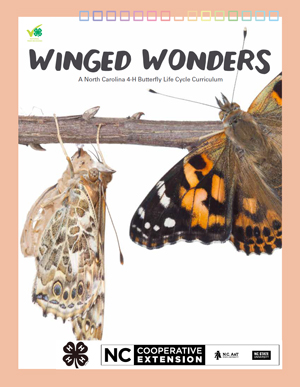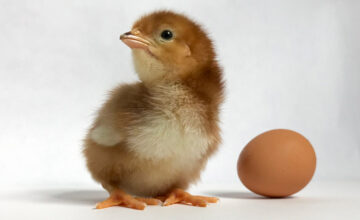
Winged Wonders
In this curriculum, youth will observe the wonders of the natural world unfolding in front of them by raising painted lady butterflies from larva through adulthood. Youth will experience the mystery of the butterfly life cycle while engaging in hands-on activities that explore concepts of insect structures and functions, compare insect behaviors and life cycles, and demonstrate the role everyone can play in environmental stewardship.
E.O. Wilson, a renowned naturalist, once called butterflies “the flowers of the air.” Beautiful with their brilliant colors, graceful flight, and benign behavior, butterflies enhance our landscapes and gardens. They are also indicators of a healthy environment and a healthy ecosystem. Butterflies play a role in pollination and serve as part of the food chain for other organisms. Butterflies serve as a gateway to understanding the natural world and a visual reminder of the need for the conservation of all living things around us.
Age range: 7-8
Grade level: 2/Elementary
A Big, Buggy World
Educational Standards:
- Next Generation Science Standards (Interdependent Relationships in Ecosystems: 2-LS4-1)
- North Carolina Essential Standards Structures and Functions of Living Organisms (2.L.1.1, 2.L.1.2)
- Common Core State Standards Key Ideas and Details (ELA-LITERACY.RL.2.3), Text Types and Purposes (ELA-LITERACY.W.2.3)
Youth will be able to describe many different types of animals with which we share the environment and the many different types of animals that share the environment with butterflies.
What is a Bug?
Educational Standards:
- Next Generation Science Standards Interdependent Relationships in Ecosystems (2-LS4-1)
- North Carolina Essential Standards Structures and Functions of Living Organisms (2.L.1.1, 2.L.1.2 )
- Common Core State Standards Research to Build and Present Knowledge (ELA-LITERACY.W.2.8), Text Types and Purposes (ELA-LITERACY.W.2.1)
Youth will be able to explain the basic physical characteristics that define insects.
Change Is Happening!
Educational Standards:
- Next Generation Science Standards Interdependent Relationships in Ecosystems (2-LS4-1)
- North Carolina Essential Standards Structures and Functions of Living Organisms(2.L.1.1, 2.L.1.2)
- Common Core State Standards Text Type and Purposes (CCSS.ELA-LITERACY.W.2.3)
- Common Core State Standards Research to Build and Present Knowledge (ELA-LITERACY.W.2.8)
Youth will be able to explain the life cycle of butterflies and other garden organisms.
Time to Grow
Educational Standards:
- Next Generation Science Standards
Dependent Relationships in Ecosystems (2-LS4-1) - North Carolina Essential Standards Structures and Functions of Living Organisms (2.L.1.1, 2.L.1.2, 2.L.2.1)
- Common Core State Standards Research to Build and Present Knowledge (ELA-LITERACY.W.2.8), Craft and Structure (RL2.4), Production and Distribution of Writing (W2.5), Measurement and Data (CCSS.MATH.CONTENT.2.MD.A.1, and 2.MD.A.4)
Youth will observe and share the life cycle of butterflies and provide proper lab treatment of animals.
This End Up
Educational Standards:
- Next Generation Science Standards Interdependent Relationships in Ecosystems (2-LS4-1)
- North Carolina Essential Standards Structures and Functions of Living Organisms (2.L.1.1, 2.L.1.2)
- Common Core State Standards
Text Types and Purposes (W2.3)
Youth will observe and analyze the role of natural instincts and behaviors in caterpillars.
Pupa Parts
Educational Standards:
- Next Generation Science Standards Interdependent Relationships in Ecosystems (2-LS4-1)
- North Carolina Essential Standards Structures and Functions of Living Organisms (2.L.1.1, 2.L.1.2)
- Common Core State Standards Conventions of Standard English (CCSS.ELA-LITERACY.L.2.1), Vocabulary Acquisition and Use (CCSS.ELA-LITERACY.L.2.4), Text Types and Purposes (W2.2), Research to Build and Present Knowledge (W2.7)
Youth will explore the pupal stage of the butterfly life cycle and be able to identify
the parts of a chrysalis.
Beautiful Butterflies
Educational Standards:
- Next Generation Science Standards (Interdependent Relationships in Ecosystems: 2-LS4-1)
- North Carolina Essential Standards (Structures and Functions of Living Organisms: 2.L.1.1, 2.L.1.2, 2.L.2.2 )
- Common Core State Standards (Text Types and Purposes: CCSS.ELA-LITERACY W2.1, W.2.2)
Youth will be able to share the structures and functions of an adult butterfly.
Beautiful Butterflies
Educational Standards:
- Next Generation Science Standards Interdependent Relationships in Ecosystems (2-LS4-1).
- North Carolina Essential Standards Structures and Functions of Living Organisms (2.L.1.1, 2.L.1.2, 2.L.2.2).
- Common Core State Standards
Text Types and Purposes (CCSS.ELA-LITERACY.W.2.1 and W.2.2)
Youth will be able to explain the differences between moths and butterflies and the adaptive significance of butterfly coloration.
The Power of Pollination
Educational Standards:
- Next Generation Science Standards (Interdependent Relationships in Ecosystems: 2-LS4-1)
- North Carolina Essential Standards (Structures and Functions of Living Organisms: 2.L.1.1, 2.L.1.2, 2.L.2.2 )
- Common Core State Standards (Text Types and Purposes: CCSS.ELA-LITERACY.W.2.2)
- Common Core State Standards (Research to Build and Present Knowledge W2.7)
Youth will summarize the concept of pollination, and the benefits of pollination to insects, plants, and humans.
The Power of Pollination
Educational Standards:
- Next Generation Science Standards (Interdependent Relationships in Ecosystems: 2-LS4-1)
- North Carolina Essential Standards (Structures and Functions of Living Organisms: 2.L.1.1, 2.L.1.2, 2.L.2.2)
Youth will examine butterfly conservation and reflect on how rearing butterflies build an awareness and appreciation of the environment and world around us.




